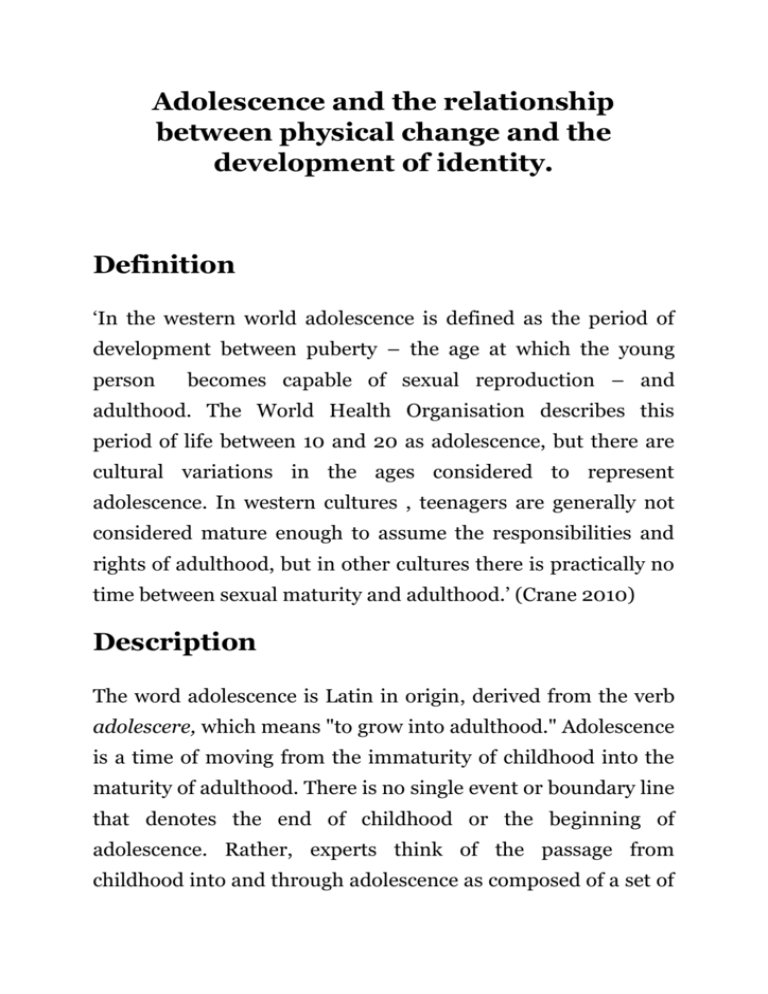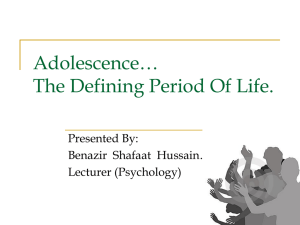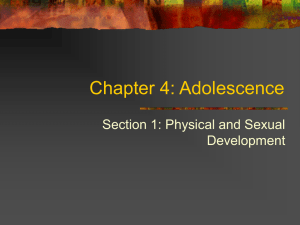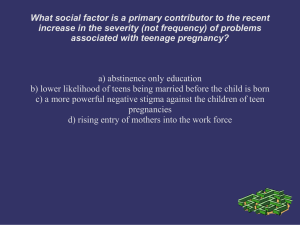
Adolescence and the relationship
between physical change and the
development of identity.
Definition
‘In the western world adolescence is defined as the period of
development between puberty – the age at which the young
person
becomes capable of sexual reproduction – and
adulthood. The World Health Organisation describes this
period of life between 10 and 20 as adolescence, but there are
cultural variations in the ages considered to represent
adolescence. In western cultures , teenagers are generally not
considered mature enough to assume the responsibilities and
rights of adulthood, but in other cultures there is practically no
time between sexual maturity and adulthood.’ (Crane 2010)
Description
The word adolescence is Latin in origin, derived from the verb
adolescere, which means "to grow into adulthood." Adolescence
is a time of moving from the immaturity of childhood into the
maturity of adulthood. There is no single event or boundary line
that denotes the end of childhood or the beginning of
adolescence. Rather, experts think of the passage from
childhood into and through adolescence as composed of a set of
transitions that unfold gradually and that touch upon many
aspects of the individual's behavior, development, and
relationships. These transitions are biological, cognitive, social,
and emotional.
Puberty
The biological transition of adolescence, or puberty, is perhaps
the most observable sign that adolescence has begun.
Technically, puberty refers to the period during which an
individual becomes capable of sexual reproduction. More
broadly speaking, however, puberty is used as a collective term
to refer to all the physical changes that occur in the growing girl
or boy as the individual passes from childhood into adulthood.
The timing of physical maturation varies widely. In the United
States, menarche (onset of menstruation ) typically occurs
around age 12, although some youngsters start puberty when
they are only eight or nine, others when they are well into their
teens. The duration of puberty also varies greatly: 18 months to
six years in girls and two to five years in boys.
The physical changes of puberty are triggered by hormones,
chemical substances in the body that act on specific organs and
tissues. In boys a major change incurred during puberty is the
increased production of testosterone, a male sex hormone,
while girls experience increased production of the female
hormone estrogen. In both sexes, a rise in growth hormone
produces the adolescent growth spurt, the pronounced increase
in height and weight that marks the first half of puberty.
Perhaps the most dramatic changes of puberty involve
sexuality. Internally, through the development of primary
sexual characteristics, adolescents become capable of sexual
reproduction. Externally, as secondary sexual characteristics
appear, girls and boys begin to look like mature women and
men. In boys primary and secondary sexual characteristics
usually emerge in a predictable order, with rapid growth of the
testes and scrotum, accompanied by the appearance of pubic
hair. About a year later, when the growth spurt begins, the
penis also grows larger, and pubic hair becomes coarser,
thicker, and darker. Later still comes the growth of facial and
body hair, and a gradual lowering of the voice. Around midadolescence internal changes begin making a boy capable of
producing and ejaculating sperm.
In girls, sexual characteristics develop in a less regular
sequence. Usually, the first sign of puberty is a slight elevation
of the breasts, but sometimes this is preceded by the
appearance of pubic hair. Pubic hair changes from sparse and
downy to denser and coarser. Concurrent with these changes is
further breast development . In teenage girls, internal sexual
changes include maturation of the uterus, vagina, and other
parts of the reproductive system. Menarche, the first menstrual
period, happens relatively late in puberty. Regular ovulation
and the ability to carry a baby to full term usually follow
menarche by several years.
Cognitive transition
A second element of the passage through adolescence is a
cognitive transition. Compared to children, adolescents think in
ways that are more advanced, more efficient, and generally
more complex. This is evident in five distinct areas of cognition.
First, during adolescence individuals become better able than
children to think about what is possible, instead of limiting
their thought to what is real. Whereas children's thinking is
oriented to the here and now (i.e., to things and events that they
can observe directly), adolescents are able to consider what
they observe against a backdrop of what is possible—they can
think hypothetically.
Second, during the passage into adolescence, individuals
become better able to think about abstract ideas. For example,
adolescents find it easier than children to comprehend the sorts
of higher-order, abstract logic inherent in puns, proverbs,
metaphors, and analogies. The adolescent's greater facility with
abstract thinking also permits the application of advanced
reasoning and logical processes to social and ideological
matters. This is clearly seen in the adolescent's increased
facility
and
interest
in
thinking
about
interpersonal
relationships, politics, philosophy, religion, and morality—
topics that involve such abstract concepts as friendship, faith,
democracy, fairness, and honesty.
Third, during adolescence individuals begin thinking more
often about the process of thinking itself, or metacognition. As a
result, adolescents may display increased introspection and
self-consciousness. Although improvements in metacognitive
abilities
provide
important
intellectual
advantages,
one
potentially negative byproduct of these advances is the
tendency for adolescents to develop a sort of egocentrism, or
intense
preoccupation
with
the
self.
Acute
adolescent
egocentrism sometimes leads teenagers to believe that others
are constantly watching and evaluating them. Psychologists
refer to this as the imaginary audience.
A fourth change in cognition is that thinking tends to become
multidimensional, rather than limited to a single issue.
Whereas children tend to think about things one aspect at a
time, adolescents describe themselves and others in more
differentiated and complicated terms and find it easier to look
at problems from multiple perspectives. Being able to
understand that people's personalities are not one-sided, or
that social situations can have different interpretations,
depending on one's point of view, permits the adolescent to
have far more sophisticated and complicated relationships with
other people.
Finally, adolescents are more likely than children to see things
as relative, rather than absolute. They are more likely to
question others' assertions and less likely to accept "facts" as
absolute truths. This increase in relativism can be particularly
exasperating to parents, who may feel that their adolescent
children question everything just for the sake of argument.
Emotional transition
Adolescence is also a period of emotional transition, marked by
changes in the way individuals view themselves and in their
capacity to function independently. As adolescents mature
intellectually and undergo cognitive changes, they come to
perceive themselves in more sophisticated and differentiated
ways. Compared with children, who tend to describe
themselves in relatively simple, concrete terms, adolescents are
more likely to employ complex, abstract, and psychological selfcharacterizations. As individuals' self-conceptions become
more abstract and as they become more able to see themselves
in psychological terms, they become more interested in
understanding their own personalities and why they behave the
way they do.
For most adolescents, establishing a sense of autonomy, or
independence, is as important a part of the emotional transition
out of childhood as is establishing a sense of identity. During
adolescence, there is a movement away from the dependency
typical of childhood toward the autonomy typical of adulthood.
For example, older adolescents do not generally rush to their
parents whenever they are upset, worried, or in need of
assistance. They do not see their parents as all-knowing or allpowerful, and often have a great deal of emotional energy
wrapped up in relationships outside the family . In addition,
older adolescents are able to see and interact with their parents
as people, not just as their parents. Many parents find, for
example, that they can confide in their adolescent children,
something that was not possible when their children were
younger, or that their adolescent children can easily sympathize
with them when they have had a hard day at work.
Being independent, however, means more than merely feeling
independent. It also means being able to make decisions and to
select a sensible course of action. This is an especially
important capability in contemporary society, where many
adolescents are forced to become independent decision makers
at an early age. In general, researchers find that decisionmaking abilities improve over the course of the adolescent
years, with gains continuing well into the later years of high
school.
Many parents wonder about the susceptibility of adolescents to
peer pressure . In general, studies that contrast parent and
peer influences indicate that in some situations, peers' opinions
are more influential, while in others, parents' are more
influential. Specifically, adolescents are more likely to conform
to their peers' opinions when it comes to short-term, day-today, and social matters—styles of dress, tastes in music, and
choices among leisure activities. This is particularly true during
junior high school and the early years of high school. When it
comes to long-term questions concerning educational or
occupational plans, however, or values, religious beliefs, and
ethical issues, teenagers are influenced in a major way by their
parents.
Susceptibility to the influence of parents and peers changes
during adolescence. In general, during childhood, boys and
girls are highly oriented toward their parents and less so toward
their peers; peer pressure during the early elementary school
years is not especially strong. As they approach adolescence,
however, children become somewhat less oriented toward their
parents and more oriented toward their peers, and peer
pressure
begins
to
escalate.
During
early
adolescence,
conformity to parents continues to decline and conformity to
peers and peer pressure continues to rise. It is not until middle
adolescence that genuine behavioral independence emerges,
when conformity to parents as well as peers declines.
Social transition
Accompanying
the
biological,
cognitive,
and
emotional
transitions of adolescence are important changes in the
adolescent's social relationships. Developmentalists have spent
considerable time charting the changes that take place with
friends and with family members as the individual moves
through the adolescent years.
One of the most noteworthy aspects of the social transition into
adolescence is the increase in the amount of time individuals
spend with their peers. Although relations with age-mates exist
well before adolescence, during the teenage years they change
in significance and structure. For example, there is a sharp
increase during adolescence in the sheer amount of time
individuals spend with their peers and in the relative time they
spend in the company of peers versus adults. In the United
States, well over half of the typical adolescent's waking hours
are spent with peers, as opposed to only 15 percent with adults,
including parents. Second, during adolescence, peer groups
function much more often without adult supervision than they
do during childhood, and more often involve friends of the
opposite sex.
Finally, whereas children's peer relationships are limited
mainly to pairs of friends and relatively small groups—three or
four children at a time, for example—adolescence marks the
emergence of larger groups of peers, or crowds. Crowds are
large collectives of similarly stereotyped individuals who may or
may not spend much time together. In contemporary American
high schools, typical crowds are "jocks," "brains," "nerds,"
"populars," "druggies," and so on. In contrast to cliques, crowds
are not settings for adolescents' intimate interactions or
friendships, but instead serve to locate the adolescent (to
himself and to others) within the social structure of the school.
As well, the crowds themselves tend to form a sort of social
hierarchy or map of the school, and different crowds are seen as
having different degrees of status or importance.
The importance of peers during early adolescence coincides
with changes in individuals' needs for intimacy. As children
begin to share secrets with their friends, loyalty and
commitment develop. During adolescence, the search for
intimacy intensifies, and self-disclosure between best friends
becomes an important pastime. Teenagers, especially girls,
spend a good deal of time discussing their innermost thoughts
and feelings, trying to understand one another. The discovery
that they tend to think and feel the same as someone else
becomes another important basis of friendship.
One of the most important social transitions that takes place in
adolescence concerns the emergence of sexual and romantic
relationships. In contemporary society, most young people
begin dating sometime during early adolescence. Dating during
adolescence can mean a variety of different things, from group
activities that bring males and females together (without much
actual contact between the sexes); to group dates, in which a
group of boys and girls go out jointly (and spend part of the
time as couples and part of the time in large groups); to casual
dating as couples; and to serious involvement with a steady
boyfriend or girlfriend. More adolescents have experience in
mixed-sex group activities like parties or dances than dating,
and more have experience in dating than in having a serious
boyfriend or girlfriend.
Reference:
http://www.healthofchildren.com/A/Adolescence.html#b









![Adolescence in 20th Century Literature and Culture [DOCX 16.08KB]](http://s3.studylib.net/store/data/006806148_1-4fb552dd69cbfa44b08b2f880802b1fe-300x300.png)
